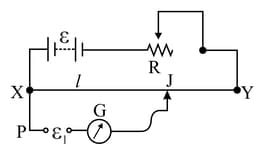Relation between Electric Current and Drift Velocity: Derivation of Ohm's Law
Important Questions on Relation between Electric Current and Drift Velocity: Derivation of Ohm's Law
The diagram below shows a potentiometer set up. On touching the jockey near to the end $X$ of the potentiometer wire, the galvanometer pointer.

deflects to left. On touching the jockey near to end $Y$ of the potentiometer, the galvanometer pointer again deflects to left but now by a larger amount. Identify the fault in the circuit and explain, using appropriate equations or otherwise, how it leads to such a one-sided deflection.
Two material bars and of equal area of cross-section, are connected in series to a supply. A is made of usual resistance wire and of an -type semiconductor.
If the same constant current continues to flow for a long time, how will the voltage drop across and be affected ?
Justify each answer.
Two material bars and of equal area of cross-section, are connected in series to a supply. A is made of usual resistance wire and of an -type semiconductor.
In which bar is drift speed of free electrons greater ?
Derive an expression for drift velocity of free electrons.
State the two Kirchhoff's rules used in electric networks. How are these rules justified?
What is a safety fuse? Explain its function.
Give four reasons why nichrome element is commonly used in household heating appliances.
Two heating elements of resistances and when operated at a constant supply of voltage, consume powers and respectively. Deduce the expressions for the power of their combination when they are, in turn, connected in parallel across the same voltage supply.
Two heating elements of resistances and when operated at a constant supply of voltage, consume powers and respectively. Deduce the expressions for the power of their combination when they are, in turn, connected in series.
Obtain the formula for the 'power loss' in a conductor of resistance carrying a current
Clarify your elementary notions about current in a metallic conductor by answering the following queries:
If the electron drift speed is so small, and the electron's charge is small, how can we still obtain large amounts of current in a conductor?
Mobilities of electrons and holes in a sample of intrinsic germanium at room temperature are and respectively. If the electron and hole densities are equal to calculate the germanium conductivity.
The number density of electrons in copper is A current of flows through a copper wire of length and area of cross-section , when connected to a battery of . Find the electron mobility.
A potential difference of is applied across a conductor of length . If the drift velocity of electrons is , find the electron mobility.
When a potential difference of is applied across a wire of length and area of cross-section , a current of flows through the wire. If the number density of free electrons in the wire is , calculate the average relaxation time. Given that mass of electron and charge on electron .
What is the drift velocity of electrons in the silver wire of length , having cross-sectional area and carrying a current of ? Given atomic mass , density of silver , charge on electron and Avogadro’s number per kg-atom.
A current of ampere is flowing through a wire of cross‐sectional area . Calculate the drift velocity of electrons. Assuming the temperature of the wire to be , also calculate the velocity at this temperature. Which velocity is larger? Given that Boltzmann’s constant , density of copper , atomic mass of copper .
A of charge flows through a wire in minutes. The radius of the wire is . It contains electrons per . Calculate the current and drift velocity.
A current of is flowing through a wire of length and cross-sectional area . If each cubic metre of the wire contains free electrons, find the average time taken by an electron to cross the length of the wire.
A copper wire of diameter carries a current of . Copper has atoms per cubic metre. Find the drift velocity of electrons, assuming that one charge carrier of is associated with each atom of the metal.

